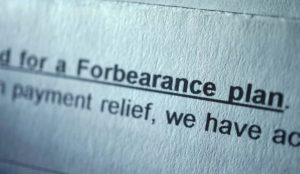
So, you have taken a mortgage forbearance due to the COVID-19 Pandemic and the time period for forbearance is over. What happens next?
First, we should define mortgage forbearance. Mortgage forbearance allows a borrower to cease making payments for a period of time. It requires approval from your mortgage lender. During forbearance, the lender cannot move to foreclose on your home, institute a foreclosure proceeding, or report the mortgage as delinquent on your credit reports.
The forbearance guidelines under the CARES Act apply only to federally backed mortgages.
Here’s how to lookup whether or not your mortgage is federally backed by Fannie Mae or Freddie Mac.
IS A MORTGAGE FEDERALLY BACKED? HERE’S HOW TO CHECK
Freddie Mac
https://ww3.freddiemac.com/loanlookup/
Fannie Mae
https://www.knowyouroptions.com/loanlookup
When you first applied for a forbearance, your lender likely said something along the lines of, “After the forbearance, your back payments will be put onto the end of the loan” or something similar. These statements provide a sense of security. You’re in crisis, cannot afford your mortgage payment due to a temporary or permanent loss of income, and are given the hope that all will be fine in the end. Your mortgage company understands that this is an unprecedented time in history and surely, it is their responsibility to help you through this time to keep your home.
In fact, there is a COVID-19 forbearance script that your mortgage company (servicer) uses with you. Here’s a link to it:
For Freddie Mac:
https://sf.freddiemac.com/content/_assets/resources/pdf/covid-19_forbearance-servicer-script.pdf
For Fannie Mae:
https://singlefamily.fanniemae.com/servicing/covid-19-forbearance-script-servicer-use-homeowners
Sound familiar? It certainly should.
Getting a mortgage forbearance is easy. The hard part is navigating getting yourself the best terms possible when you resume making your mortgage payment.
Here are your available options:
Reinstatement: Hard for the average homeowner to do. You make a lump sum payment for the payments owed during forbearance period and resume making your regular monthly mortgage payment.
Repayment: Again, this can prove challenging. You catch up on your payments missed during forbearance during a period of time set out by the lender. It increases your monthly housing outlay as you pay your regular monthly mortgage payment and also a portion of the mortgage arrears each month.
If you are able to afford repayment, but not the terms that the lender is offering, know that Chapter 13 Bankruptcy is a solid option. Chapter 13 Bankruptcy forces your mortgage lender to give you up to 60 months to pay back the mortgage arrears in equal monthly installments while resuming your regular monthly payment. I am here to help you get back on track with your mortgage through a Chapter 13 Bankruptcy.
If you are unable to reinstate the loan or afford the repayment options your lender is offering, stop there and let’s talk about making smart moves to keep you in your home.
Loan Modification: Let’s say you can afford to resume your regular monthly mortgage payment, but cannot afford reinstatement, repayment options your lender is offering, or amortizing the mortgage arrears over up to 60 months in a Chapter 13 Bankruptcy.
The next option is a loan modification. I cannot implore you enough not to do this on your own. The forms are simple, the information requested is basic, and it looks like anyone can do this themselves.
Please remember, even if a representative from your mortgage company (customer service representative says you have the right to a loan modification, there is no guarantee that you will get a loan modification. There is no obligation for your lender to offer you a loan modification after a forbearance. Yes, of course your lender has to give you the paperwork to apply for a loan modification, but it does not guarantee you will get a loan modification.
Here’s the missing link, and where I come in.
The loan modification application is the absolute last piece to a successful loan modification.
It’s all in the preparation and precision in presenting the best case for a loan modification to your mortgage lender.
Every mortgage loan is different. First, I need to determine whether it is a federally backed loan or a private mortgage. No secrets here. I simply use the lookup tools I provided above.
Then, I prepare what is called a Request for Information (RFI) to your mortgage lender. Under Consumer Financial Protection Bureau Regulations (CFPB), I use 12 CFR 1024.36 to attain the necessary data and information to determine, with certainty, the following:
- How your mortgage company should be reviewing your mortgage for a loan modification,
- What the likelihood of success will be.
- What the terms of the mortgage modification should look like.
- How your income and expenses should be presented to the mortgage lender to maximize your chances of success.
- What income, both gross and net, you need to show your lender in order to qualify for any sort of mortgage modification. This applies both to W2 employees and those who are self-employed or business owners.
- What federal loan modification programs apply to your mortgage.
- If a private mortgage, what programs your lender is offering internally for loan modifications.
- Do you qualify for the payment deferral option as a homeowner in a COVID-19 forbearance plan?
Then, your lender has a federally proscribed amount of time to respond to the RFI. By law, they have to respond to my RFI. If they do not respond to the RFI, I hit them with what is called a Notice of Error (NOE) under 12 CFR 1024.35 (b)(5) again requesting the information. It is entirely possible that your lender does not respond to repeated NOEs. If that is the case, it can give us a counterclaim to the foreclosure that your lender was not in good faith working to offer you a loan modification. In addition, it can provide traction in front of a bankruptcy judge in a chapter 13 case.
Ok, let’s assume that I get the RFI information back. I run the information provided through a proprietary analytics program based on your specific loan information.
Then, I prepare your loan modification application to qualify you for the best program option available based on your circumstances and goals.
I look forward, as always, to meeting with you to discuss your options and how I can best be of assistance to you during a difficult time.
Hang in there!
So, you have taken a mortgage forbearance due to the COVID-19 Pandemic and the time period for forbearance is over. What happens next?
First, we should define mortgage forbearance. Mortgage forbearance allows a borrower to cease making payments for a period of time. It requires approval from your mortgage lender. During forbearance, the lender cannot move to foreclose on your home, institute a foreclosure proceeding, or report the mortgage as delinquent on your credit reports.
The forbearance guidelines under the CARES Act apply only to federally backed mortgages.
Here’s how to lookup whether or not your mortgage is federally backed by Fannie Mae or Freddie Mac.

IS A MORTGAGE FEDERALLY BACKED? HERE’S HOW TO CHECK
Freddie Mac
https://ww3.freddiemac.com/loanlookup/
Fannie Mae
https://www.knowyouroptions.com/loanlookup
When you first applied for a forbearance, your lender likely said something along the lines of, “After the forbearance, your back payments will be put onto the end of the loan” or something similar. These statements provide a sense of security. You’re in crisis, cannot afford your mortgage payment due to a temporary or permanent loss of income, and are given the hope that all will be fine in the end. Your mortgage company understands that this is an unprecedented time in history and surely, it is their responsibility to help you through this time to keep your home.
In fact, there is a COVID-19 forbearance script that your mortgage company (servicer) uses with you. Here’s a link to it:
For Freddie Mac:
https://sf.freddiemac.com/content/_assets/resources/pdf/covid-19_forbearance-servicer-script.pdf
For Fannie Mae:
https://singlefamily.fanniemae.com/servicing/covid-19-forbearance-script-servicer-use-homeowners
Sound familiar? It certainly should.
Getting a mortgage forbearance is easy. The hard part is navigating getting yourself the best terms possible when you resume making your mortgage payment.
Here are your available options:
Reinstatement: Hard for the average homeowner to do. You make a lump sum payment for the payments owed during forbearance period and resume making your regular monthly mortgage payment.
Repayment: Again, this can prove challenging. You catch up on your payments missed during forbearance during a period of time set out by the lender. It increases your monthly housing outlay as you pay your regular monthly mortgage payment and also a portion of the mortgage arrears each month.
If you are able to afford repayment, but not the terms that the lender is offering, know that Chapter 13 Bankruptcy is a solid option. Chapter 13 Bankruptcy forces your mortgage lender to give you up to 60 months to pay back the mortgage arrears in equal monthly installments while resuming your regular monthly payment. I am here to help you get back on track with your mortgage through a Chapter 13 Bankruptcy.
If you are unable to reinstate the loan or afford the repayment options your lender is offering, stop there and let’s talk about making smart moves to keep you in your home.
Loan Modification: Let’s say you can afford to resume your regular monthly mortgage payment, but cannot afford reinstatement, repayment options your lender is offering, or amortizing the mortgage arrears over up to 60 months in a Chapter 13 Bankruptcy.
The next option is a loan modification. I cannot implore you enough not to do this on your own. The forms are simple, the information requested is basic, and it looks like anyone can do this themselves.
Please remember, even if a representative from your mortgage company (customer service representative says you have the right to a loan modification, there is no guarantee that you will get a loan modification. There is no obligation for your lender to offer you a loan modification after a forbearance. Yes, of course your lender has to give you the paperwork to apply for a loan modification, but it does not guarantee you will get a loan modification.
Here’s the missing link, and where I come in.
The loan modification application is the absolute last piece to a successful loan modification.
It’s all in the preparation and precision in presenting the best case for a loan modification to your mortgage lender.
Every mortgage loan is different. First, I need to determine whether it is a federally backed loan or a private mortgage. No secrets here. I simply use the lookup tools I provided above.
Then, I prepare what is called a Request for Information (RFI) to your mortgage lender. Under Consumer Financial Protection Bureau Regulations (CFPB), I use 12 CFR 1024.36 to attain the necessary data and information to determine, with certainty, the following:
- How your mortgage company should be reviewing your mortgage for a loan modification,
- What the likelihood of success will be.
- What the terms of the mortgage modification should look like.
- How your income and expenses should be presented to the mortgage lender to maximize your chances of success.
- What income, both gross and net, you need to show your lender in order to qualify for any sort of mortgage modification. This applies both to W2 employees and those who are self-employed or business owners.
- What federal loan modification programs apply to your mortgage.
- If a private mortgage, what programs your lender is offering internally for loan modifications.
- Do you qualify for the payment deferral option as a homeowner in a COVID-19 forbearance plan?
Then, your lender has a federally proscribed amount of time to respond to the RFI. By law, they have to respond to my RFI. If they do not respond to the RFI, I hit them with what is called a Notice of Error (NOE) under 12 CFR 1024.35 (b)(5) again requesting the information. It is entirely possible that your lender does not respond to repeated NOEs. If that is the case, it can give us a counterclaim to the foreclosure that your lender was not in good faith working to offer you a loan modification. In addition, it can provide traction in front of a bankruptcy judge in a chapter 13 case.
Ok, let’s assume that I get the RFI information back. I run the information provided through a proprietary analytics program based on your specific loan information.
Then, I prepare your loan modification application to qualify you for the best program option available based on your circumstances and goals.
I look forward, as always, to meeting with you to discuss your options and how I can best be of assistance to you during a difficult time.
Hang in there!
REQUEST A FREE CONSULTATION
Fill out the form below to receive a free and confidential initial consultation. Or call:
732-737-7985



